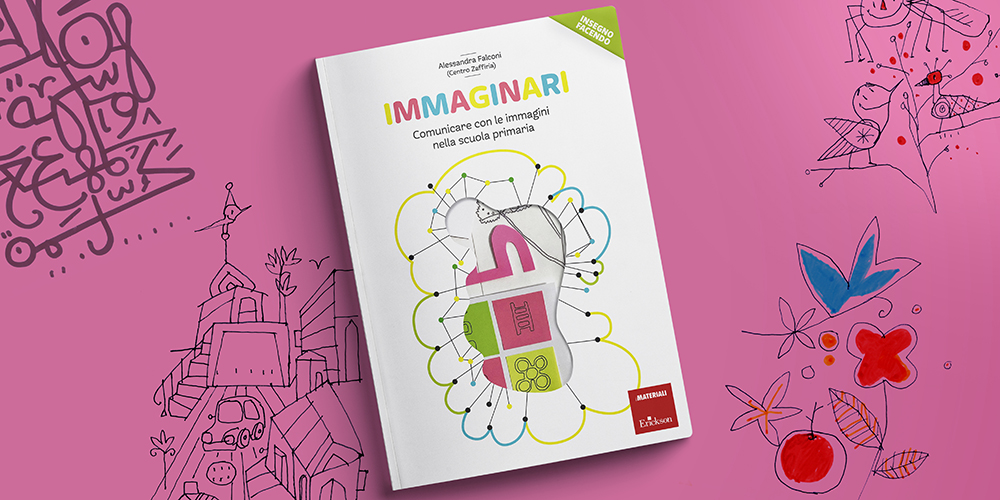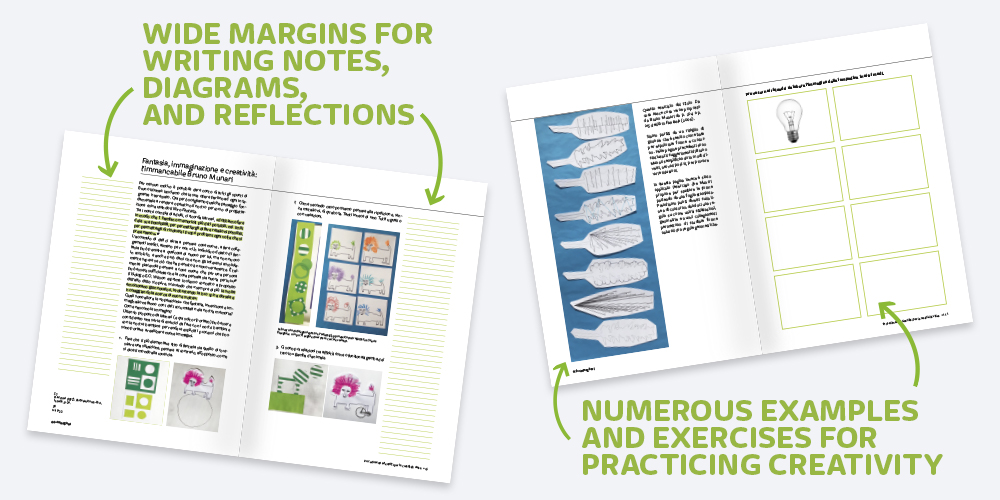 EN
EN
 PT
PT
Communicating with images in primary school
Product: Book
Trim size in cm: 21x29,7cm
Pages: 184
ISBN: 9788859021452
Publication date: 01/06/2020
Suitable for: Primary 1st level (ages 6-7), Primary 2nd level (ages 8-10)
REQUEST A SAMPLE OR MORE INFORMATION
Imaginary is a workbook for all primary school teachers who wish to organize artistic activities that support the experience of boys and girls through reflections on symbols, icons and signs. It offers several workshops that focus on understanding these signs and developing new ones, learning and interpreting, stimulating pupils to build hypotheses, designing, experimenting and understanding nature and the world.
A journey
Imaginary is a journey, an itinerary in the company of artists and scientists from all over the world (Bruno Munari, Alberto Manzi, Marie and Otto Neurath, Mirò, Walid Taher, Takei Takeo, Hans Arp and Sophie Taeuber Arp, Pino Tovaglia and Ladislav Sutnar), that trains the ability to question the surrounding reality and oneself, to make choices, to know the structure of the images and to build one’s own visual vocabularies.
A notebook
Imaginary is a notebook in which the teacher can erase, draw patterns, and add notes because in order to offer activities to children, it is necessary to try them first and take time to adapt them to different needs. Here is a notebook that allows for experimentation, adjustment and testing.
To do together
Visual communication at school
Premise with accompanying notes
In a kingdom of images
First steps towards visual communication
Scientific procedure for visual creativity
Fantasy, imagination and creativity: the unmissable Bruno Munari
Visual methods
How do images work?
The Ludographe: knowing and practicing graphic design in primary school
Visual explanations for children. Working with Marie and Otto Neurath
A language of symbols and signs?
Doing science and mathematics with images
Wandering among the images of artists and designers
In Miro’s garden
Producing images with an Arabic artist: Walid Taher
Producing images with a Japanese artist: Takei Takeo
The cosmic shapes of Hans Arp and Sophie Taeuber-Arp
Pino Tovaglia: the rule that corrects emotion
Ladislav Sutnar: visual design «in action»
If I only had a pair of scissors….and a few stars
Conclusion… but maybe not
Bibliography and sitography

Communicating with images in primary school

A workbook for primary school teachers, for imagining and planning an educational path about visual art.
Inspired by Bruno Munari’s creative workshops and teacher Alberto Manzi’s educational approach, Imaginary offers a journey in the company of artists and scientists from all over the world that trains the students’ and teachers’ ability to question the surrounding reality and oneself, to make choices, to know the structure of the images and to build one's own visual vocabularies.
A WORKBOOK, NOT A BOOK
Imaginary is a workbook because it was created with the goal of stimulating the teachers’ practical abilities, putting them in the conditions to experiment and plan didactic activities that work on the students’ skills to know, think, and communicate through images. In the workbook, things can be erased, schemes can be built, notes can be added, keeping track of what you think is important – in writing or with drawings. Before proposing the activities to the class, the teacher is invited to take some time for his/herself, and get involved, using the notebook to elaborate new ideas based on the context of his/her own sensitivities and curiosities.

STRUCTURE AND CONTENTS
After an in-depth introduction on the importance of images and visual communication at school, Imaginary presents some scientific procedures useful for stimulating and enhancing visual creativity. Subsequently, the workbook explores the techniques and characteristics of the work of some important figures in the world of art and design (Mirò, Walid Taher, Takei Takeo, Hans Arp and Sophie Taeuber-Arp, Pino Tovaglia, Ladislav Sutnar), giving the teacher additional ideas for workshops that can be done in class.
Leaf through some pages of the book that have been translated into English:
THE AUTHOR
Centro Zaffiria promotes media education, experiments with a divergent and poetic use of technology, develops educational materials and games, designs and implements workshops and initiatives for boys and girls, and shares ideas and projects with teachers and families.
Take a look at the other titles by Centro Zaffiria: